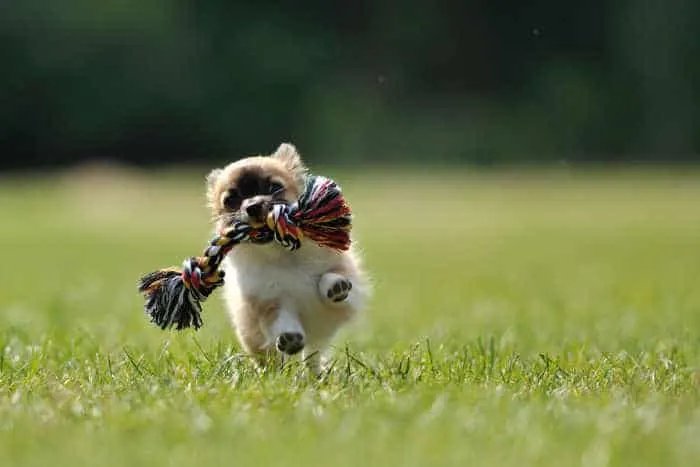Check out these great training tips in this guest post!

As the pet parent of your beloved Chihuahua, you know that your furry friend is a truly smart breed. In fact, while other dogs can be difficult, your best friend’s smart and obedient behavior makes them one of the easiest breeds to train.
Yet, it’s important to note that because your Chihuahua has a heightened level of intelligence, this can often make them more headstrong, independent and even stubborn. While this may affect some aspects of your training, there’s no need to worry. Chihuahua’s are a loyal breed and listen to their owners who they love and trust.
In any case, training a new puppy takes work. So, you should be prepared for some ups and downs when it comes to teaching your pet the basics of living in your home. To help you make the process smoother, here are 4 tips we suggest you utilize while training your new Chihuahua puppy.
4 Tips For Training Your New Chihuahua
Show Strong Leadership & Don’t Be Afraid to Be Dominant
The first rule in training your new Chihuahua puppy is to assert your leadership. As the owner, you need to show dominance and loving control with your pet so that they will listen to your commands with obedience.
While no one likes to have to reprimand their dog, it’s important to not let them “walk all over you” and act as if they are in control. In all, even though they are little fur balls of love, they can and will take advantage of you if they sense any initial signs of weakness during training.
Leadership and dominance in training your puppy can be showcased in a few ways:
- Using a more stern tone of voice – not yelling at your dog, but more straightforward and with specific commands. You’ll want to avoid any baby talk or a high pitch tone of voice that often signals emotions of approval.
- Standing over your dog to put yourself at a higher vantage point.
- Using hand gestures such as pointing when expressing a command.
In all, the best way for your Chihuahua to listen and respect you during the training process is to remember that you are the owner and leader. Be stern to promote obedience and good behavior.
Set A Routine / Schedule For Eating

The second tip for training your new Chihuahua is to set a routine and schedule for eating.
Dogs behave well when they have a routine they can anticipate and stick to. So, during the training stage – it’s important to create a schedule that works for you and that your dog can get used to over time.
Eating/feeding times may be the most important part of the schedule as it will set the timeline for the day. Your dog will most likely eat 1 to 2 meals a day with a few treats in between. Identifying the time for these meals will help your dog stay on track and set their internal clock to know when it is and isn’t time to eat.
To train your dog to understand meal times, be strict with the time between meals. Avoid any extra food unless it’s a treat for when they do their business outside. If you feed your Chihuahua too sporadically or at random times during the day they will not only get confused, but potentially act out.
Disobedience in the form of begging or barking can occur when a dog doesn’t take to their set meal times. So, this tip is highly important to focus on during your training.
Take Your Puppy Out For Exercise Often

The third tip is to make sure you are taking your puppy out for exercise several times during the day. You can do this by having them chase a ball around the yard or taking them for a walk around the neighborhood.
Chihuahua’s have a lot of energy, so you’ll want to make sure that they are effectively burning this in the form of exercise instead of being cooped up in the house all day. In general, exercise is great for your dog no matter the breed. You want your dog to stay healthy and happy, therefore with daily exercise you can take the necessary steps to make sure they live a long, healthy life.
Another way that you can effectively take care of your new Chihuahua is by getting them set up with a pet insurance policy as soon as you bring them home. Pet insurance is the only way that you can guarantee your furry friend will be covered no matter what. With accidents, illness and the unexpected, pet insurance will take care of any medical attention your dog needs and save you thousands in expensive veterinary bills.
Fursure is a team of pet insurance gurus that will help you broker the best policy for your budget. With customized options, they can create a plan for your Chihuahua and match you with the best provider for your family. To try it out for yourself, simply schedule a free consultation call to learn everything you need to get your best friend covered.
Set Boundaries in Your Home
The final tip for training your new Chihuahua puppy is to set boundaries in your home.
Now, this point is truly up to you as the pet owner and what you feel comfortable with. Many pet owners allow their dogs to sit on the furniture and have full reign of the house, while others prefer to set barriers and be selective about where their dog is allowed.
No matter what you choose, you’ll need to be intentional about what is and isn’t allowed by your Chihuahua. Let’s say that for example, you don’t mind your dog going into any room in the house, but you don’t want them to sit on a specific couch in your living room.
In order to establish this boundary, you may need to start by setting physical elements up, so that your pet is unable to jump onto the couch. If the rest of the furniture is free of barricades, the hope is that your dog will understand that this specific couch is off limits.
Yet, you’re most likely going to have to pay attention and wait for the moment when they actually try to sit on the couch as it’s bound to happen during the training process.
When this happens, simply tell them “No” and signal with your hand for them to get down. If they don’t listen or understand you may need to pick them up off the couch and place them back on the floor.
In any case, you’ll want to use the word “No” with a stern voice and authoritative tone. This is the perfect situation to practice your leadership and dominance to make it clear that the couch is off limits and not allowed for your Chihuahua.
This aspect of training may take longer than others, but it’s important to stay patient. Your dog and you are learning together on how to have a happy and healthy relationship filled with good behavior and obedience.
![]()
As you can see, training a new Chihuahua puppy is going to take some work, patience and dedication. But, it’s not impossible. Your Chihuahua is a smart pup and will pick up on your guidance and leadership quickly.
Be sure to follow these tips – to assert your dominance, set a feeding time schedule, take your puppy out for plenty of exercise and set boundaries around your home.
We are confident that by following these tips, you’ll have your new Chihuahua puppy trained in no time. We wish you the best of luck!

Marie
Saturday 5th of September 2020
How do you make your dog stop pulling when your walking.
Cathy
Saturday 5th of September 2020
It's a little complicated to go into in a comment, but basically you hold the leash taut without a lot of room for the dog to pull ahead and practice the "heel" command. Whenever the dog starts to pull, you stop, say heel and wait til the dog stands beside you without pulling, Then you start walking again. You do this everytime to dog starts to pull ahead. If your dog is food motivated, you can also give them a small treat when they do the command correctly to encourage them at first. Taking a dog training class at one of the big box pet stores (PetCo, PetSmart) is a good idea too as this is one of the first commands they teach.